Machine Learning
“Machine intelligence is the last invention that humanity will ever need to make.” ~Nick
Need for Machine Learning
It means through machine learning, we can make the computers read like how the parents make their child read. It makes it possible through the use of Algorithms. Basically, an algorithm contains the step by step procedure of solving a problem. When a problem occurs, the computer usually goes through the algorithms to solve it step by step and get it out. It means, through machine learning, we were making the machines/ computers to learn themselves rather than explicitly being handled by the Computer system. The main intention of machine learning is to give training data to the machine learning algorithms. This learning algorithm makes a new set of rules based on inferences from the data. This, in turn, generates a new algorithm formally known as machine learning model.
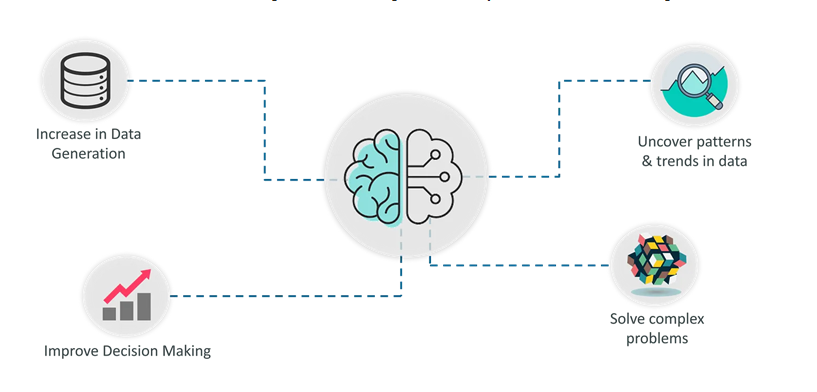
Introduction To Machine Learning
The term Machine Learning was first coined by Arthur Samuel in the year 1959. Looking back, that year was probably the most significant in terms of technological advancements.
If you browse through the net about ‘what is Machine Learning’, you’ll get at least 100 different definitions. However, the very first formal definition was given by Tom M. Mitchell:
“A computer program is said to learn from experience E with respect to some class of tasks T and performance measure P if its performance at tasks in T, as measured by P, improves with experience E.” In simple terms, Machine learning is a subset of Artificial Intelligence (AI) which provides machines the ability to learn automatically & improve from experience without being explicitly programmed to do so. In the sense, it is the practice of getting Machines to solve problems by gaining the ability to think.
But wait, can a machine think or make decisions? Well, if you feed a machine a good amount of data, it will learn how to interpret, process and analyze this data by using Machine Learning Algorithms, in order to solve real-world problems.
Before moving any further, let’s discuss some of the most commonly used terminologies in Machine Learning.
Machine Learning Definitions Algorithm: A Machine Learning algorithm is a set of rules and statistical techniques used to learn patterns from data and draw significant information from it. It is the logic behind a Machine Learning model. An example of a Machine Learning algorithm is the Linear Regression algorithm.
Model: A model is the main component of Machine Learning. A model is trained by using a Machine Learning Algorithm. An algorithm maps all the decisions that a model is supposed to take based on the given input, in order to get the correct output.
Predictor Variable: It is a feature(s) of the data that can be used to predict the output.
Response Variable: It is the feature or the output variable that needs to be predicted by using the predictor variable(s).
Training Data: The Machine Learning model is built using the training data. The training data helps the model to identify key trends and patterns essential to predict the output.
Testing Data: After the model is trained, it must be tested to evaluate how accurately it can predict an outcome. This is done by the testing data set.

Machine Learning Process:
The Machine Learning process involves building a Predictive model that can be used to find a solution for a Problem Statement. To understand the Machine Learning process let’s assume that you have been given a problem that needs to be solved by using Machine Learning.
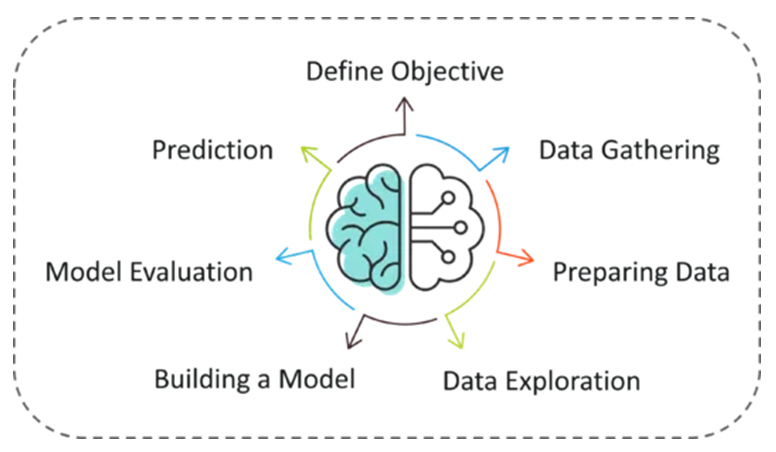
The problem is to predict the occurrence of rain in your local area by using Machine Learning.
The below steps are followed in a Machine Learning process:
Step 1: Define the objective of the Problem Statement
At this step, we must understand what exactly needs to be predicted. In our case, the objective is to predict the possibility of rain by studying weather conditions. At this stage, it is also essential to take mental notes on what kind of data can be used to solve this problem or the type of approach you must follow to get to the solution.
Step 2: Data Gathering
At this stage, you must be asking questions such as,
What kind of data is needed to solve this problem?
Is the data available?
How can I get the data?
Once you know the types of data that is required, you must understand how you can derive this data. Data collection can be done manually or by web scraping. However, if you’re a beginner and you’re just looking to learn Machine Learning you don’t have to worry about getting the data. There are 1000s of data resources on the web, you can just download the data set and get going.
Coming back to the problem at hand, the data needed for weather forecasting includes measures such as humidity level, temperature, pressure, locality, whether or not you live in a hill station, etc. Such data must be collected and stored for analysis.
Step 3: Data Preparation
The data you collected is almost never in the right format. You will encounter a lot of inconsistencies in the data set such as missing values, redundant variables, duplicate values, etc. Removing such inconsistencies is very essential because they might lead to wrongful computations and predictions. Therefore, at this stage, you scan the data set for any inconsistencies and you fix them then and there.
Step 4: Exploratory Data Analysis
Grab your detective glasses because this stage is all about diving deep into data and finding all the hidden data mysteries. EDA or Exploratory Data Analysis is the brainstorming stage of Machine Learning. Data Exploration involves understanding the patterns and trends in the data. At this stage, all the useful insights are drawn and correlations between the variables are understood.
For example, in the case of predicting rainfall, we know that there is a strong possibility of rain if the temperature has fallen low. Such correlations must be understood and mapped at this stage.
Step 5: Building a Machine Learning Model
All the insights and patterns derived during Data Exploration are used to build the Machine Learning Model. This stage always begins by splitting the data set into two parts, training data, and testing data. The training data will be used to build and analyze the model. The logic of the model is based on the Machine Learning Algorithm that is being implemented.
In the case of predicting rainfall, since the output will be in the form of True (if it will rain tomorrow) or False (no rain tomorrow), we can use a Classification Algorithm such as Logistic Regression.
Choosing the right algorithm depends on the type of problem you’re trying to solve, the data set and the level of complexity of the problem. In the upcoming sections, we will discuss the different types of problems that can be solved by using Machine Learning.
Step 6: Model Evaluation & Optimization
After building a model by using the training data set, it is finally time to put the model to a test. The testing data set is used to check the efficiency of the model and how accurately it can predict the outcome. Once the accuracy is calculated, any further improvements in the model can be implemented at this stage. Methods like parameter tuning and cross-validation can be used to improve the performance of the model.
Step 7: Predictions
Once the model is evaluated and improved, it is finally used to make predictions. The final output can be a Categorical variable (eg. True or False) or it can be a Continuous Quantity (eg. the predicted value of a stock).
In our case, for predicting the occurrence of rainfall, the output will be a categorical variable.
So that was the entire Machine Learning process. Now it’s time to learn about the different ways in which Machines can learn.
Machine Learning Types:
A machine can learn to solve a problem by following any one of the following three approaches. These are the ways in which a machine can learn:
1.Supervised Learning:
2.Unsupervised Learning:
3.Reinforcement Learning:
Supervised Learning:
Supervised learning is a technique in which we teach or train the machine using data which is well labeled. To understand Supervised Learning let’s consider an analogy. As kids we all needed guidance to solve math problems. Our teachers helped us understand what addition is and how it is done. Similarly, you can think of supervised learning as a type of Machine Learning that involves a guide. The labeled data set is the teacher that will train you to understand patterns in the data. The labeled data set is nothing but the training data set. A machine can learn to solve a problem by following any one of the following three approaches. These are the ways in which a machine can learn:
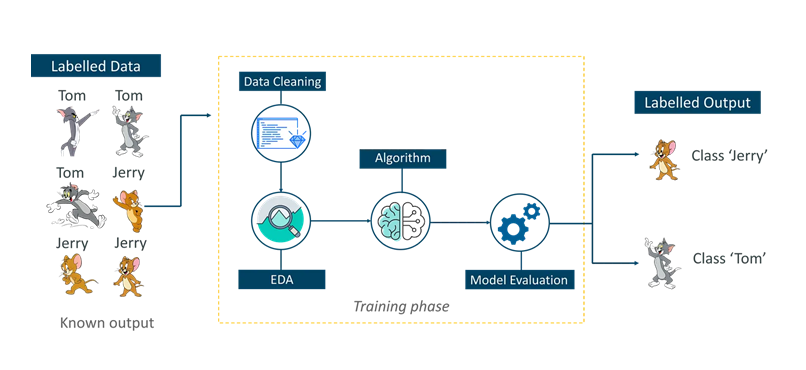
Consider the above figure. Here we’re feeding the machine images of Tom and Jerry and the goal is for the machine to identify and classify the images into two groups (Tom images and Jerry images). The training data set that is fed to the model is labeled, as in, we’re telling the machine, ‘this is how Tom looks and this is Jerry’. By doing so you’re training the machine by using labeled data. In Supervised Learning, there is a well-defined training phase done with the help of labeled data.
Unsupervised learning:
Unsupervised learning also known as unsupervised machine learning, uses machine learning algorithms to analyze and cluster unlabeled datasets. These algorithms discover hidden patterns or data groupings without the need for human intervention. Its ability to discover similarities and differences in information make it the ideal solution for exploratory data analysis, cross-selling strategies, customer segmentation, and image recognition.
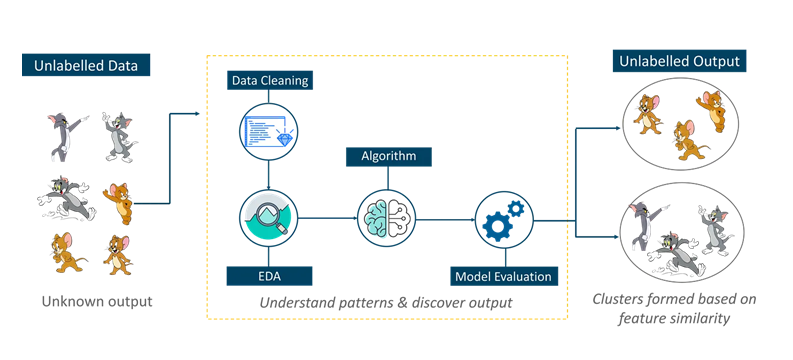
For example, it identifies prominent features of Tom such as pointy ears, bigger size, etc. to understand that this image is of type 1. Similarly, it finds such features in Jerry and knows that this image is of type 2. Therefore, it classifies the images into two different classes without knowing who Tom is or Jerry is.
Reinforcement Learning:
Reinforcement Learning is a part of Machine learning where an agent is put in an environment and he learns to behave in this environment by performing certain actions and observing the rewards which it gets from those actions.
Reinforcement learning is an area of Machine Learning. It is about taking suitable action to maximize reward in a particular situation. It is employed by various software and machines to find the best possible behavior or path it should take in a specific situation. Reinforcement learning differs from the supervised learning in a way that in supervised learning the training data has the answer key with it so the model is trained with the correct answer itself whereas in reinforcement learning, there is no answer but the reinforcement agent decides what to do to perform the given task. In the absence of a training dataset, it is bound to learn from its experience.
Example: The problem is as follows: We have an agent and a reward, with many hurdles in between. The agent is supposed to find the best possible path to reach the reward. The following problem explains the problem more easily.
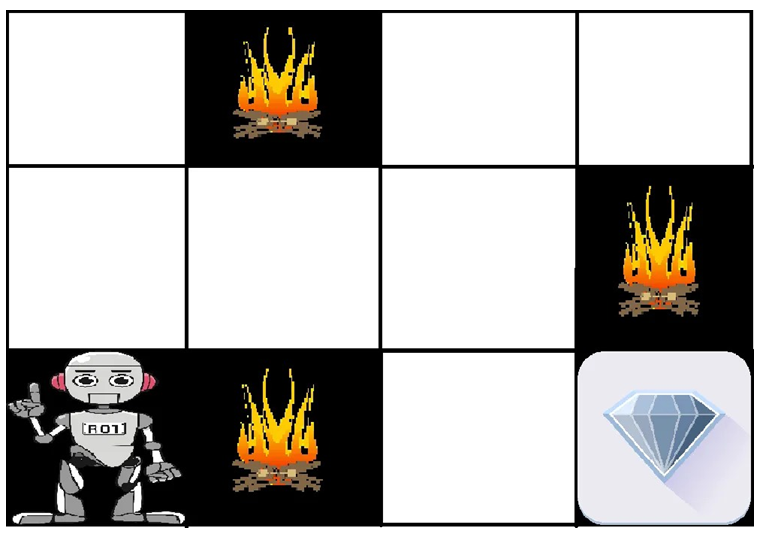
The above image shows the robot, diamond, and fire. The goal of the robot is to get the reward that is the diamond and avoid the hurdles that are fire. The robot learns by trying all the possible paths and then choosing the path which gives him the reward with the least hurdles. Each right step will give the robot a reward and each wrong step will subtract the reward of the robot. The total reward will be calculated when it reaches the final reward that is the diamond.
Cyclic process to build an efficient machine learning project:
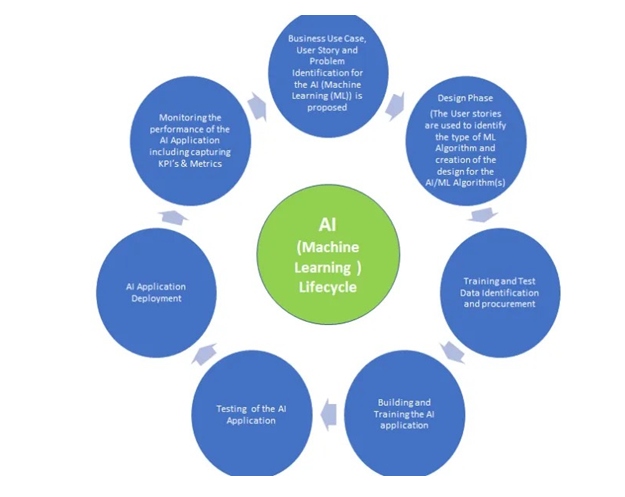
Machine learning has given the computer systems the abilities to automatically learn without being explicitly programmed. But how does a machine learning system work? So, it can be described using the life cycle of machine learning. Machine learning life cycle is a cyclic process to build an efficient machine learning project. The main purpose of the life cycle is to find a solution to the problem or project.
Machine learning life cycle involves seven major steps, which are given below:
- Gathering Data
- Data preparation
- Data Wrangling
- Analyze Data
- Train the model
- Test the model
- Deployment
The most important thing in the complete process is to understand the problem and to know the purpose of the problem. Therefore, before starting the life cycle, we need to understand the problem because the good result depends on the better understanding of the problem. In the complete life cycle process, to solve a problem, we create a machine learning system called “model”, and this model is created by providing “training”. But to train a model, we need data, hence, life cycle starts by collecting data.
1. Gathering Data
Data Gathering is the first step of the machine learning life cycle. The goal of this step is to identify and obtain all data-related problems. In this step, we need to identify the different data sources, as data can be collected from various sources such as files, database, internet, or mobile devices. It is one of the most important steps of the life cycle. The quantity and quality of the collected data will determine the efficiency of the output. The more will be the data, the more accurate will be the prediction.
This step includes the below tasks:
- Identify various data sources
- Collect data
- Integrate the data obtained from different sources
2. Data preparation
After collecting the data, we need to prepare it for further steps. Data preparation is a step where we put our data into a suitable place and prepare it to use in our machine learning training. In this step, first, we put all data together, and then randomize the ordering of data. This step can be further divided into two processes: o Data exploration: It is used to understand the nature of data that we have to work with. We need to understand the characteristics, format, and quality of data. A better understanding of data leads to an effective outcome. In this, we find Correlations, general trends, and outliers. o Data pre-processing: Now the next step is preprocessing of data for its analysis.
3. Data Wrangling
Data wrangling is the process of cleaning and converting raw data into a useable format. It is the process of cleaning the data, selecting the variable to use, and transforming the data in a proper format to make it more suitable for analysis in the next step. It is one of the most important steps of the complete process. Cleaning of data is required to address the quality issues. It is not necessary that data we have collected is always of our use as some of the data may not be useful. In real-world applications, collected data may have various issues, including: o Missing Values o Duplicate data o Invalid data o Noise So, we use various filtering techniques to clean the data.
4. Data Analysis
Now the cleaned and prepared data is passed on to the analysis step.
This step involves:
- Selection of analytical techniques
- Building models
- Review the result
The aim of this step is to build a machine learning model to analyze the data using various analytical techniques and review the outcome. It starts with the determination of the type of the problems, where we select the machine learning techniques such as Classification, Regression, Cluster analysis, Association, etc. then build the model using prepared data, and evaluate the model.
5. Train Model
Now the next step is to train the model, in this step we train our model to improve its performance for better outcome of the problem. We use datasets to train the model using various machine learning algorithms. Training a model is required so that it can understand the various patterns, rules, and, features.
6. Test Model
Once our machine learning model has been trained on a given dataset, then we test the model. In this step, we check for the accuracy of our model by providing a test dataset to it. Testing the model determines the percentage accuracy of the model as per the requirement of project or problem.
7. Deployment
The last step of machine learning life cycle is deployment, where we deploy the model in the real-world system. If the above-prepared model is producing an accurate result as per our requirement with acceptable speed, then we deploy the model in the real system. But before deploying the project, we will check whether it is improving its performance using available data or not. The deployment phase is similar to making the final report for a project.